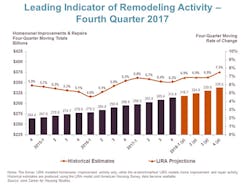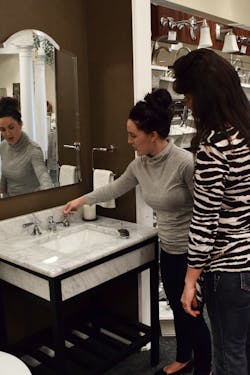Latest from Remodeling
Sponsored
STEADY GAINS in the economy, as well as in residential sales and prices, support a growing demand for home remodeling in 2018. The Leading Indicator of Remodeling Activity released mid-January by the Joint Center for Housing Studies of Harvard University projected that homeowner spending on improvements and repairs will approach $340 billion in 2018, an increase of 7.5 percent from estimated 2017 spending.
"Despite continuing challenges of low for-sale housing inventories and contractor labor availability, 2018 could post the strongest gains for home remodeling in more than a decade," said Abbe Will, research associate in the Remodeling Futures Program at the JCHS. "Annual growth rates have not exceeded 6.8 percent since early 2007 before the Great Recession hit."
In addition, due to last year's record-setting natural disasters, many areas of the country should see a boost in the remodeling market from ongoing restoration efforts, explains Chris Herbert, managing director of the Joint Center for Housing Studies.
Meanwhile, at the 2018 International Builder’s Show held in late January, the National Association of Home Builders Remodelers forecasted that spending on residential remodels will continue to grow at a modest pace in the next two years, citing increased consumer confidence — remodeling spending for owner-occupied single-family homes will increase 4.9 percent in 2018 over 2017 and an additional 0.6 percent in 2019.
Regardless of statistics, it seems that bath-and-kitchen remodelers can expect more business this year as the economy continues to strengthen.
“With the economy continuing to strengthen, many homeowners are choosing to invest in their homes with larger renovation projects than in the past,” said Jean-Jacques L’Henaff, vice president of design at LIXIL Americas (parent company of American Standard and Grohe). “Increased financial confidence is fueling homeowners to tackle full-room remodels that improve their lifestyle, versus the smaller, necessity-driven upgrades done when the economy was weaker.”
Raleigh, N.C.-based bath-and-kitchen showroom Splash Galleries, opened in 2003 by master plumber Gary Philips, brought in $1 million in sales last year and expects a 20 percent increase in remodeling business this year. Showroom Manager Lauren Philips notes the home remodeling increase in the area is partly due because of the cost of new homes.
“In our area, new construction homes are not favoring the side of ‘starting home’ price points, so a lot of remodels are completed so homeowners can remain in the area they want without having to build a custom home,” she explained. “We also continue to see an increase in the desire for people to stay in their homes. This means thinking about the future needs of the homeowners and creating a space for them that is functional without looking institutional.”
Farther north, Avon, Conn.-based Avon Plumbing & Heating saw a 20 percent increase in bathroom remodeling sales from 2016 to 2017 and expects to see a 10 percent increase this year. Stacy Moore, Avon project manager and designer, notes that the showroom’s quality of service is a big contributor to the sales increase.
“I am very optimistic about 2018,” she said. “Most of our employees have worked at Avon Plumbing their entire careers. It gives an immense level of comfort to our customers; they know us and trust us. They repay us in referrals, as well as their own repeat remodeling jobs.”
Bath-and-kitchen smart tech
Homeowners are looking for ways they can incorporate tech into almost every room of the home — yes, even the bathroom.
“We’re starting to see bathrooms work smarter for consumers,” said Michael Poloha, senior product manager at Moen. “It’s the room where you start your day and wind down for the night, so it’s only natural that smart home elements would begin to be integrated into this space. Smart home fixtures also allow homeowners to become more efficient with their day and completely personalize their experience.”
'The biggest trend in our market right now is bathrooms with a future.'
L’Henaff agreed: “From shower heads that feature capacitive touch technology to enhance and streamline the user experience to spa toilets and toilet seats offering bidet functions, heated seats and nightlights, the presence of technology in the bathroom is likely to continue to grow in the coming years.”
In the kitchen, touchless faucets provide users with the added convenience of not having to touch the faucet when hands are too full or too messy, notes Tom Tylicki, senior product manager at Moen. They also aid in reducing cross-contamination when prepping food.
Universal design continual bath trend
The bulk of showroom sales for Avon Plumbing and Splash Galleries come from bath remodels; 90 percent and 70 percent, respectively. So, what trends are they seeing with their client base? The buzz words seem to be aging in place.
“The biggest trend in our market right now is bathrooms with a ‘future,’” Moore said. “As our clients ‘age in place,’ they rely on our expertise to remodel for accessibility and, at the same time, embrace modern products with stylish touches. For example, zero-threshold showers embrace a contemporary feel but also allow for accessibility down the road.”
Philips agreed: “We have seen a huge increase in level-entry showers for all bathrooms, not only in the master bath. This allows us to give the customer a seamless transition into the shower without altering the structural integrity of the floor system.”
L’Henaff said incorporating elements of universal design is an important trend. “By 2030, the 65+ population will have surged up by more than 65 percent, creating a steady demand for universal design for years to come,” he said. “This category includes everything from faucets with ADA-compliant lever handles to no-threshold showers to walk-in bathtubs.”
When it comes to faucet finishes in the bathroom, gold is making headway for homeowners. “Non-traditional finishes are now more popular in the bathroom,” Poloha said. “In the past, gold fixtures have been associated with traditional design. Now, the finish is also being incorporated into homes with a modern aesthetic for a fresh take on a classic style. The brushed gold finish blends seamlessly with a variety of décor styles.”
While conservative finishes such as polished chrome and polished nickel are still more popular with Splash Galleries’ clients, Philips is seeing more requests for brushed gold in the bath. “I think it will quickly become one of the more popular finishes this year,” she noted.
Philips added that freestanding tubs continue to be selected over drop-in models. However, customers are opting for wall-mounted or tub-mounted faucets rather than the more traditional floor-mounted faucets.
Kitchen trends: Mixed metals
Today’s homeowners are experimenting with different metals and finishes in their kitchens.
“We are seeing a lot more ‘mixed metals’ in the kitchen,” Philips said. “The finishes for faucets are getting more creative, such as black nickel, antique brass and graphite. We’ve seen a huge increase in matte black cabinet hardware, as that mixes well with some of the harder-to-match faucet finishes.”
“Consumers are no longer satisfied with cookie-cutter designs, they want personalization in both style and functionality,” noted Tylicki. “More consumers are open to experimenting with color, whether it be mixing the colors of their cabinetry or fixtures. In regard to fixtures, matte black continues to be a popular option, as is it works with just about every style and color palette.”
Depending on whom you talk to, stainless-steel kitchen sinks are in — or out.
“We are seeing fewer stainless steel-sinks selected by clients,” Philps said. “Our most popular sinks are quartz under-mount sinks and cast-iron farmhouse sinks. The kitchen sink can really pull together the entire look of the kitchen, so they play a much bigger role now than they did in years past.”
L’Henaff agreed: “Farmhouse sinks are trending because they highlight a simple design always in style while offering homeowners a roomy sink basin that can easily tackle most kitchen tasks. They also provide a more comfortable setting for working at the kitchen sink, since there is no counter between the user and the sink bowl.”
He adds that consumers are showing more interest in pull-down kitchen faucet models over two-handle and pull-out styles that were once very popular in kitchens with traditional décor. With spray options and pause features, they help simplify common kitchen tasks.

Kelly L. Faloon | Freelance Writer/Editor
Kelly L. Faloon is a contributing editor and writer to Contractor, Contracting Business magazine and HPAC Engineering and principal of Faloon Editorial Services. The former editor of Plumbing & Mechanical magazine, Faloon has more than 26 years of experience in the plumbing and heating industry and more than 35 years in B2B publishing. She started a freelance writing and editing business in 2017, where she has a varied clientele.
Faloon spent 3 1/2 years at Supply House Times before joining the Plumbing & Mechanical staff in 2001. Previously, she spent nearly 10 years at CCH/Wolters Kluwer, a publishing firm specializing in business and tax law, where she wore many hats — proofreader, writer/editor for a daily tax publication, and Internal Revenue Code editor.
A native of Michigan’s northern Lower Peninsula, Faloon is a journalism graduate of Michigan State University. You can reach her at [email protected].




